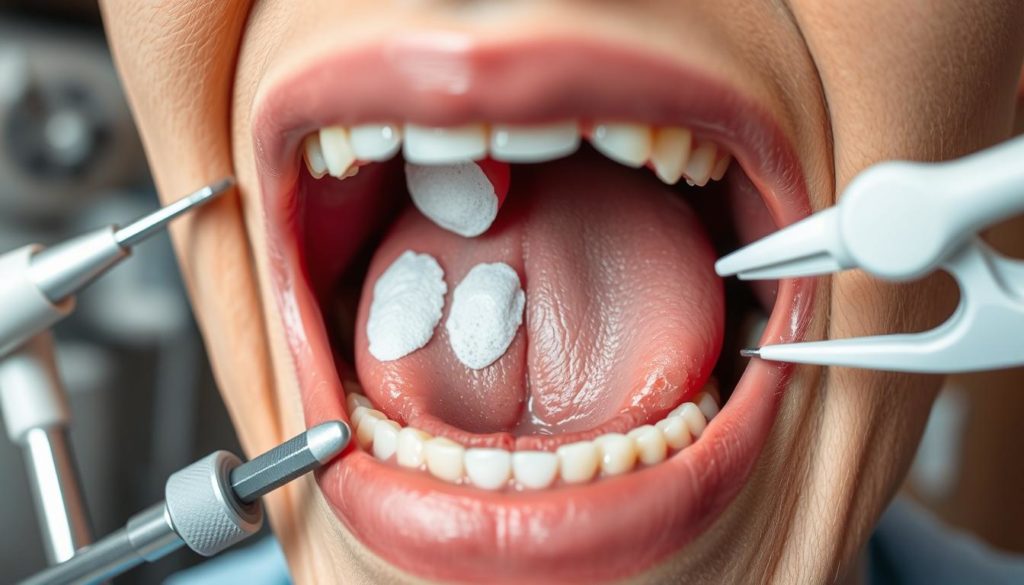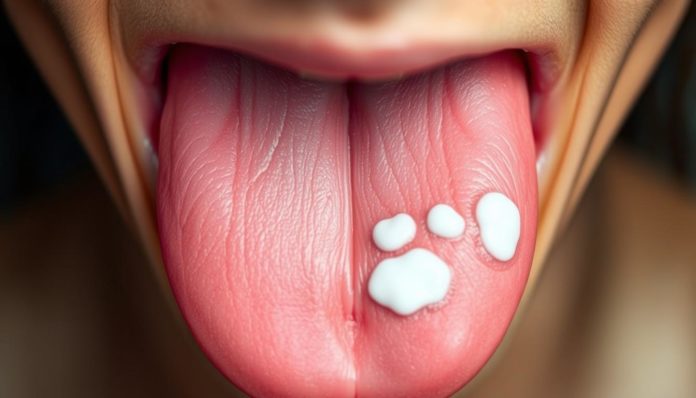Nearly 3% of people worldwide may face leukoplakia. This condition can lead to cancerous oral spots. It shows how critical awareness and knowledge about this oral health risk are.
Leukoplakia isn’t just a simple mouth sore. It’s a major dental health concern. It needs detailed dental care and careful handling. Our discussion focuses on the risks of leukoplakia. We will also talk about ways to control and lessen these risks for better oral health.
Knowing about leukoplakia is crucial. Taking early and effective precautions can help protect our oral health. Let’s learn together. This guide will help us tackle leukoplakia challenges and lead us to healthier smiles.
What is Leukoplakia?
Leukoplakia shows up as thick, white patches in the mouth. It mostly affects gums, cheek insides, mouth floor, and sometimes the tongue. It’s key to know about it because of the risks to dental health.

Definition and Characteristics
Oral leukoplakia has white plaques that you can’t scrape off. Researchers are still figuring out what causes it, but tobacco is a common link. The patches look thicker or harder than other oral issues.
Common Symptoms
It’s important to spot leukoplakia signs early for quick help. The patches are often painless and easy to miss. Yet, eating hot or spicy things may feel different.
If patches grow or change color, see a dentist. This is to make sure there’s nothing more serious happening.
Understanding the Risks of Leukoplakia
Leukoplakia isn’t just a white spot in your mouth. It comes with serious leukoplakia risks. These risks can lead to major illness if not handled quickly. Knowing about these risks and acting fast is key.

Potential Health Complications
Leukoplakia can cause a lot of health problems. Issues like long-lasting mouth sores, swelling, and a lot of pain can really affect your life. If you don’t take care of these early signs, you might face things like infections and losing teeth.
Oral Cancer Concerns
One big worry with leukoplakia is it might turn into oral cancer. If you smoke or drink a lot, this risk goes up. A lot of times, leukoplakia shows changes that could lead to cancer. That’s why it’s critical to keep an eye on it and get tests done often.
Leukoplakia Dental Health
Leukoplakia deeply affects dental health care. It shows why we must manage it well. Regular dental checks are crucial for spotting it early. This way, treatment can start soon with various leukoplakia treatment options.
Keeping your mouth clean is key to stop leukoplakia. Brushing twice a day, flossing, and rinsing with mouthwash help a lot. These simple steps cut down the risks.
Let’s talk about some leukoplakia treatment options and why they matter for maintaining oral hygiene:
| Treatment Option | Description |
|---|---|
| Topical Medications | These include retinoids and other cell growth regulators applied directly to the lesion to reduce its size. |
| Laser Surgery | Using laser technology to remove leukoplakia patches with precision, promoting faster healing and less post-operative discomfort. |
| Photodynamic Therapy | A technique combining photosensitizing agents with light to target and destroy abnormal cells. |
Leukoplakia treatment options work well, but the best strategy is to avoid problems. This means keeping up with oral hygiene and seeing your dentist regularly. Proper dental health care controls symptoms and prevents worse issues from leukoplakia.
Causes of Leukoplakia
Leukoplakia often comes from lifestyle choices that hurt oral health. Knowing these causes helps prevent and treat it.
Smoking and Tobacco Use
Smoking and using tobacco play a big role in oral problems like leukoplakia. Tobacco’s chemicals irritate the mouth, causing white patches. Both smoking and using smokeless tobacco up the risk.
Alcohol Consumption
Drinking too much alcohol is another cause of leukoplakia. It irritates the mouth’s lining, making conditions right for leukoplakia. When used with tobacco, alcohol makes oral health problems worse.
Poor Oral Hygiene
Bad oral hygiene leads to leukoplakia too. Brushing and flossing well are key to stop plaque and bacteria. Ignoring dental care invites leukoplakia among other issues.
| Contributing Factors | Description |
|---|---|
| Smoking and Tobacco Use | Increases the risk of tobacco-related oral conditions by introducing harmful chemicals to the mouth. |
| Alcohol Consumption | Alcohol and oral health concerns rise with increased irritation of the mouth’s mucous membranes. |
| Poor Oral Hygiene | Neglecting oral hygiene importance can lead to bacterial buildup and irritants in the mouth. |
Diagnosing Leukoplakia
Finding leukoplakia early is key to stopping it from getting worse, possibly into oral cancer. This section talks about how to diagnose leukoplakia. It covers regular dental check-ups, biopsy procedures, and spotting areas in the mouth that are likely to be high-risk.
Dental Exams and Screenings
Regular dentist visits are crucial for catching leukoplakia early on. Dentists look for unusual white spots or sores in the mouth. They use special tools and methods during these exams. This helps them make a correct diagnosis of leukoplakia.
Biopsy Procedures
If there’s a suspicious white spot, you might need an oral biopsy. This test takes a small sample from the spot to analyze it. The biopsy is important for deciding if the lesion is benign or could turn into cancer. It helps in making the right plan for treatment.
Identifying High-Risk Areas
Dentists are trained to spot places in the mouth that have a higher chance of being cancerous. They look for lesions with certain traits that might mean they’re more likely to be malignant. Finding these areas early can help doctors manage the condition better, improving leukoplakia detection.
| Diagnostic Method | Description | Importance |
|---|---|---|
| Dental Exams | Routine check-ups focusing on identifying suspicious lesions. | Early detection and monitoring. |
| Oral Biopsy | Sampling tissue from lesions for lab testing. | Confirming diagnosis and assessing risk. |
| High-Risk Identification | Identifying areas with specific malignancy indicators. | Targeted interventions and monitoring. |
Treatment Options for Leukoplakia
Various approaches are considered for leukoplakia treatment based on its severity. The medical community has several strategies for managing oral lesions. These are aimed at patients diagnosed with this oral pathology.
To address leukoplakia, stopping smoking and drinking alcohol may help. Doctors might prescribe topical medications like retinoids. Sometimes, antiviral drugs are used when a viral infection causes lesions.
For surgical treatment, removing the lesion is a choice, done under local anesthesia. More severe cases might need larger tissue removal. Another method is laser surgery, which uses light to target abnormal cells.
Here is a brief overview of leukoplakia treatment options:
| Treatment Type | Description | Effectiveness |
|---|---|---|
| Topical Medications | Application of medicines directly to the lesion | Moderate |
| Antiviral Drugs | Utilized in cases with viral causes | Varies |
| Simple Excision | Removal of lesions under local anesthesia | High |
| Laser Surgery | Less invasive focused light therapy | High |
Choosing the right leukoplakia treatment is essential. The decision depends on how far the lesions have progressed. Regular check-ups are crucial for successful treatment and to prevent the lesions from returning.
Preventing Leukoplakia
Proper oral hygiene and key lifestyle changes are crucial for preventing leukoplakia. These steps help significantly reduce your risk. They keep your mouth healthier.
Oral Hygiene Practices
To lower the risk of leukoplakia, an effective oral care routine is vital. Here are some recommended practices:
- Brush your teeth at least twice a day using fluoride toothpaste.
- Floss daily to remove food particles and plaque between your teeth.
- Rinse your mouth with an antiseptic mouthwash to reduce bacteria.
- Schedule regular dental check-ups and professional cleanings.
Lifestyle Changes
Healthy lifestyle choices, along with a solid oral care routine, help prevent leukoplakia. Some beneficial changes are:
- Quit smoking and tobacco use: Smoking and using tobacco can greatly increase your leukoplakia risk.
- Limit alcohol consumption: Alcohol irritates your mouth’s lining, increasing leukoplakia chances.
- Adopt a balanced diet: Eat plenty of fruits, vegetables, and whole grains to improve overall health.
| Oral Hygiene Practice | Benefit |
|---|---|
| Brushing | Reduces plaque and bacteria |
| Flossing | Removes food particles and prevents gum disease |
| Mouthwash | Kills bacteria and freshens breath |
| Regular Dental Visits | Early detection and prevention |
By sticking to these oral hygiene practices and healthy lifestyle changes, you can fight against leukoplakia. This keeps your oral health in top shape.
Maintaining Good Oral Health
Keeping your mouth healthy is more than just brushing and flossing every day. It means living in a way that keeps your teeth and gums well. Paying attention to preventing oral problems can greatly lower your chances of getting issues like leukoplakia.
Regular Dental Check-ups
Seeing your dentist regularly is key to catching problems early. Dentists spot issues you might miss. By going for check-ups and cleanings about twice a year, you get expert screenings and advice that’s right for you.
These visits are a big part of stopping dental problems before they start. They help keep your smile healthy for a long time.
Healthy Diet and Nutrition
Eating right is crucial for oral health, but it’s often ignored. A nutrient-rich diet makes your whole body healthier, including your teeth and gums. Eat plenty of calcium, vitamins, and antioxidants found in dairy, greens, and fruits to strengthen your oral health.
Cutting down on sugar and acidic foods can also prevent tooth decay and erosion. This makes your mouth healthier.
In short, a mix of regular dental visits and eating well helps maintain good oral health. These habits are your best defense against leukoplakia and other dental problems.
FAQ
What causes leukoplakia?
Several factors can cause leukoplakia. These include smoking, using tobacco, and heavy drinking. Poor oral hygiene can also lead to it. Dental prosthetics or rough teeth might irritate and cause leukoplakia.
How is leukoplakia diagnosed?
Doctors diagnose it through a dental exam. They look for white sores in the mouth. Sometimes, a biopsy is done to check the areas and confirm.
What are common symptoms of leukoplakia?
Symptoms include white or grayish patches in the mouth. These patches can be thick and slightly raised. They are found on gums, cheeks, bottom of the mouth, or tongue.
What are the risks associated with untreated leukoplakia?
If not treated, leukoplakia can lead to oral cancer. It’s important to monitor and treat it early.
How is leukoplakia treated?
Treatment may involve quitting smoking or fixing dental problems. Sometimes, medical or surgical treatments are needed. Good oral hygiene is also key.
Can leukoplakia be prevented?
Preventing leukoplakia involves good oral hygiene and avoiding tobacco and too much alcohol. Regular dentist visits help too.
Why are regular dental check-ups important for managing leukoplakia?
Regular check-ups help spot and monitor leukoplakia early. This can stop it from worsening and lower cancer risks.
How does lifestyle affect the risk of developing leukoplakia?
Smoking, drinking, and poor oral hygiene raise leukoplakia risks. A healthy lifestyle can prevent it.
What role does diet play in maintaining oral health?
A nutrient-rich diet boosts oral health and gum repair. Fruits, vegetables, and dairy are good for oral health and can prevent leukoplakia.
Are there any specific oral hygiene practices to prevent leukoplakia?
Brushing twice a day with fluoride toothpaste and flossing helps. Using antiseptic mouthwash and regular dental cleanings are key to preventing leukoplakia.


